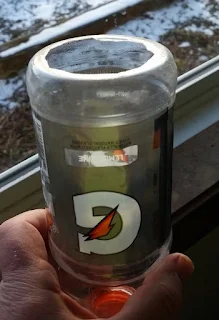Air-layering is a method of propagating plants that is little used today because it is labor intensive and requires more hands than God endowed humans with.
The method involves "tricking" the plant into thinking that a portion of the stem is in contact with the soil such as might happen during a storm where a limb partially breaks off and sags to the ground.
The canny gardener finds some way to bind a wad of soil to the limb he wants to propagate. The wad of soil eliminates sunlight (with blue light being the most likely to limit rooting), the moisture and possibly the CO2 convincing the plant to venture forth some roots.
He might also partially sever the limb to limit flow of carbohydrates down to the roots (as might happen if the limb had been damaged in a storm and was connected to the tree by a fragile strand of wood-and-bark. He might also wound the bark to initiate callous formation. If he has rooting hormones, he might use those as well.
The labor intensive part involves needing a bunch of hands to position the wad of soil (or peat or sawdust) and "rolling the doobie" with the protective wrap to keep it from drying out. Remember, the soil has to be in contact with the limb and evenly distributed to block out light.
I am lazy
I rarely do much air-layering but I am stepping up my efforts. Part of why I am doing this is because I get excited about eliminating "waste" and the amount of labor in conventional air-layering is wasteful.
Or maybe it is because I am inherently lazy and will use the easiest way available to do something.
So instead of a wad of soil and a limp, plastic wrap, I am experimenting with sport-drink containers with part of the bottom cut out.
 |
| This is a young Illinois Everbearing Mulberry and it has about five shoots that are appropriate for air-layering. |
I still make a couple of wraps with a wire at the base of the shoot to choke off carbohydrate flow back to the roots. I also do some scarring with the pliers that I use to tighten the wraps of wire. But the actual application of the air-layer is very easy.
I cut the limb below any forks. I cut it at an angle but that is not particularly important. I fill the sport-drink bottle with a light-weight, peat-based potting soil and then I slide it down the shoot, up-side down.
DONE.
The large mouth on the sport-drink bottle makes it easy to slide down the stem.
The limb that the sucker originates from stoppers-up the opening and limits the loss of potting mix out the bottom.
Now all I have to do is to keep an eye on the layers for roots and then decide when I want to separate it from the mother plant.


I've had success with rockwool cubes and tinfoil.
ReplyDeleteGood to know.
DeleteLooks promising but I do wonder how you're keeping the soil inside that bottle if IF it rains a lot?
ReplyDeletePlease keep us informed about this.
Also, a list of fruit trees you find worth growing as your in my grow zone and I'm tired of prima donna fruit trees.
I used the plastic bottle technique as Joe shows here. My solution was a tightly wrapped aluminum foil held in place with twine at the upper end of the bottle.
DeleteThe problem with that is the foil has to be removed to add water. Poking holes through the bottle to facilitate ease in adding water becomes another way for moisture to escape and perhaps to allow light to enter.
I have had limited success with air layering. Of course, its my fault but because my get er done done gone and went. Air layering, the methods I used, demand attention.
ReplyDeleteKeeping the medium, whether actual soil or sphagnum moss, from drying out is key. Knowing how much and how often to add water is key, in fact will determine your success.
My efforts were in Zones 8 through 10. I suspect even less arid zones would require periodic addition of water due to lower humidity levels.
Charles Malki is a degreed botantist. His videos are worth watching. Here he speaks on air layering. Charles in in south California. His grandfather brought the first Valencia orange tree to California. (S. CA used to be a world powerhouse in growing Valencia and Navel oranges.)
https://m.youtube.com/@IVOrganic
Failure is permissible. The prize is knowing why the failure.
ReplyDeleteLook up air layering bulbs on amazing or other online seller, their reusable, about a buck each and work like magic.
ReplyDeleteDoes it work for apple trees?
ReplyDeleteYes. However, I don't know about every variety. I know it works on Fuji and Granny Smith.
DeleteYeah, but can you propagate hardwood stems asexually Anna? Huh? Can you? ERJ readers want to know this stuff, damn you Anna!
ReplyDeleteStep off Anglia, Anna is MINE!!
ReplyDelete